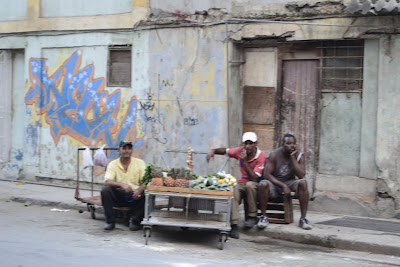There aren’t many dance floors in the world that Dan and I won’t be in the middle of. But at Havana’s Casa de la Musica on a Friday night, we were wedged to our seats, chucking back mojitos in a frantic bid to find the courage to step onto it.
It was like no dance floor I’ve ever seen – at only 7pm the place was heaving with Habaneros, rhythm coursing through their bodies as they moved with unparalled style. The men, dressed down in t-shirts and jeans or up in fedoras and snakeskin shoes, spun, ducked and dipped as much as their partners. The women, in short shorts or heels and dresses, followed effortlessly. It wasn’t just that the dancers were awesome – but the fact that they were all dancing salsa, and we didn’t know a single step.
We went with a crew from our language school. Most of the students were also learning salsa, but I had foolishly decided Spanish lessons would be enough. We watched as the dance instructors, who went along too, launched into one incredible line dance after another….
Dan, who is an awesome dancer, looked gutted. “We’ve missed a trick here,” he said. “We thought the key to Cuban culture was the language, and it’s not, it’s dance and music. That’s how they express themselves.”
He’s right. There is music everywhere. As one guide book says “any Cuban who says they can’t dance, is lying – or they don’t have enough Cuban blood in them.” We’ve seen teenage boys carrying footballs launch into salsa steps as a band struck up on the terrace of a hotel. A frail old woman joined them. The ladies on the tills in the ill-stocked supermarket sit and sing loudly to the radio. I glimpse a dozen middle-aged women crammed into a tiny living room dancing around the TV. Bici-taxis and old American cars are proudly kitted out with stereos. At a local jazz bar the young band plays with the skills of musicians twice their age.
The patio at the local brewery one Sunday afternoon was typical – as soon as a salsa band struck up people leapt to their feet. Here’s our friend Javier after a few too many pints….
Every town has a “Casa de la Musica”, or “Casa de La Trova”, where black and white photos of Cuban greats who have played there line the wooden walls. In tiny Baracoa, the dancing spilled out onto the street. In Trinidad a wide set of stone steps descending to an outdoor dance floor were packed every night. Some of the best music we’ve heard was in Santiago de Cuba, where the sound is influenced by Caribbean and African beats. In a little town hall, we watched this band in action –
Check out the bass guitarist’s speaker…..
And I’ll never forget this man, who sung like a storyteller….
Cuban music is as infectious as his smile, and we couldn’t spend a month there without joining in. And so Dan I started salsa lessons in Havana (the dancing kind, not the cooking… my lovely Dad did ask…) Everyone at our school got their own dance teacher – Dan’s was a tiny little thing called Jasmine, and mine a cuddly young man called Lazaro, who sung his heart out to every song we danced to. We picked up the basic steps quickly – but the problem for us was that our instructors didn’t speak English, and our Spanish is so crap we never knew which move was coming next. Still, it was awesome fun – especially for me. I only had to follow Lazaro, whereas Dan had to learn how to lead, which takes much longer.
Our first outing with our newly acquired salsa steps was to Jardin de 1830, a garden outside an old colonial house beside the sea. The tiny outdoor dance floor was full of a bunch of elderly couples pulling incredible salsa moves. My favourite woman was about 80 - dressed in what looked like her nightie, she kept pushing her partner away so she could high kick her way back to him. It was a tad intimidating, especially when the young blood arrived, the speed of the music increased, and the dark corners we’d hoped to practise in didn’t exist.
We knocked back a few mojitos and with the encouragement of Eva, an Irish friend and salsa legend who gives the locals a run for their money, tried a few steps. It didn’t go that well. Dan asked why I could do certain moves with Lazaro, and not with him. “Because you’re not a professional dancer,” I snapped back. We’ve got a way to go – but we love it, and we both agree we want to be back in Cuba when we’re 60 joining the oldies on that dance floor, so we’ll keep practising. (Here's Dan strutting his stuff at New Year...)




























